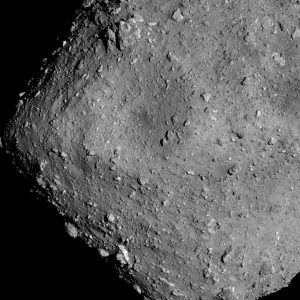
Scientists studying soil samples returned from asteroid Ryugu have confirmed that the near-Earth object is home to a slew of organic compounds, most importantly one that is essential to the formation of DNA, along with the metabolically-essential vitamin B3. This discovery suggests that life on our planet may not have originated on Earth, but may have come from elsewhere in the cosmos.
On July 11, 2019, the Japanese spacecraft Hayabusa2 (Peregrine falcon 2) briefly touched down on the surface of 162173 Ryugu when the one kilometer wide (0.6-mile) asteroid was 300 million kilometers (185 million miles) from Earth, just long enough to scoop up a subsurface soil sample from the diamond-shaped ball of gravel and rocks.
The sealed sample container returned to Earth on December 5, 2020, greeted by a scientific community eager to study the first samples collected from an asteroid. These samples that revealed that the water-bearing, 100 kilometer (60 mile)-wide celestial body that Ryugu had originated from formed roughly two million years into the solar system’s formation, and migrated between a point close to the Sun and the fringes of the solar system before being blasted apart by a smaller object, releasing the material that would become the asteroid orbiting near us today.
But a recent analysis on the chemical makeup of Ryugu yielded a surprise for its investigators: alongside 15 amino acids that are utilized by terrestrial biology that were identified in the samples, a compound called uracil was found, one of the five fundamental nitrogen compounds called nucleobases that make up deoxyribonucleic acid, or DNA. Additionally, niacin—also known as vitamin B3—was found in the samples, a compound essential for the metabolic processes of biological organisms.
Although these five nucleobases have been found in samples taken from meteorites recovered after they fell to Earth, there was always concern that these samples had been contaminated by exposure to the environment after striking the planet; however, since Hayabusa2’s sample-return capsule (SRC) was sealed immediately after it received the material was gathered, the chances of terrestrial contamination are essentially zero.
But did these molecules form as a result of a reaction triggered by exposure to cosmic radiation, or were these compounds present in the interstellar molecular cloud that the solar system eventually formed from? Perhaps more clues will be revealed when similar samples collected from asteroid 101955 Bennu, gathered by NASA’s OSIRIS-Rex, return to Earth this September.
Subscribers, to watch the subscriber version of the video, first log in then click on Dreamland Subscriber-Only Video Podcast link.
Good news for a Universe teaming with life.